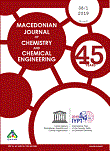Relation between learning approaches of chemistry students and their achievement in general chemistry
DOI:
https://doi.org/10.20450/mjcce.2019.1784Abstract
This research was conducted with the aim of investigating the relationship between students’ approaches to learning chemistry and their levels of achievement. The sample was comprised of 46 students in the first year of the Faculty of Sciences in Novi Sad (Serbia). The research involved two instruments: a knowledge test and an instrument for assessing the learning approach. The results showed that students have difficulties in understanding the factors that influence the chemical equilibrium, as well as with writing equations of the chemical reaction of salt hydrolysis. Most students use a deep approach to learning chemistry content. The deep approach significantly correlates with student achievement. On the basis of these results, it is concluded that is important to create a climate in the classroom that will encourage a deep approach to the study of chemistry.
References
J. H. Van Driel, W. Gräber, The teaching and learning of chemical equilibrium In: Chemical Education: Towards Research-Based Practice, J. K. Gilbert, O. de Jong, R. Justi, D. F. Treagust, J. H. van Driel (Eds.), Springer Science & Business Media, 2002 pp. 271–292.
K. W. Voska, H. W. Heikkinen, Identification and analysis of student conceptions used to solve chemical equilibrium problems, J. Res. Sci. Teach., 37, 160–176 (2000).
V. Kind, Beyond appearances: Students’ miscon-ceptions about basic chemical ideas, Sch. Educ., 1–84 (2004). DOI:10.1017/CBO9781107415324.004.
S. Olić, J. Adamov, The relationship between learning styles and students` chemistry achievement, Mac. J. Chem. Chem. Eng., 37, 79–88 (2018).
DOI: 10.20450/mjcce.2018.1400.
K. Orwat, P. Bernard, A. Migdał-Mikuli, Alternative conceptions of common salt hydrolysis among upper-secondary-school students, J. Balt. Sci. Educ., 16, 64–76 (2017).
O. de Jong, D. F. Treagust, The teaching and learning of electrochemistry in: Chemical Education: Towards Research-Based Practice, J. K. Gilbert, O. de Jong, R. Justi, D. F. Treagust, J. H. van Driel (Eds.), Springer Science & Business Media, 2002, pp. 317–337.
N. J. Entwistle, V. McCune, H. Tait, The Approaches And Study Skills Inventory For Students (ASSIST). Centre for Research on Learning and Instruction, University of Edinburgh, 1997.
H. F. Gadelrab, Factorial structure and predictive validity of approaches and study skills inventory for students (ASSIST) in Egypt: A confirmatory factor analysis approach. J. Res. Educ. Psy., 9, 1197–1218 (2011).
S. Mirkov, Pristupi učenju i ispitivanja delovanja sredinskih činilaca. Zbornik Instituta za pedagoška istraživanja, 41, 25–44 (2009).
M. Baeten, E. Kyndt, K. Struyven, F. Dochy, Using student-centred learning environments to stimulate deep approaches to learning: Factors encouraging or discouraging their effectiveness. Educ. Res. Rev., 5, 243–260 (2010). DOI: 10.1016/j.edurev.2010.06.001
C. Gordon, R. Debus, Developing deep learning approaches and personal teaching efficacy within a preservice teacher education context. Brit. J. Educ. Psy., 72, 483–511 (2002). DOI: 10.1348/00070990260377488
P. Zeegers, Approaches to learning in science: A longitudinal study. Brit. J. Educ. Psy., 71, 115–132 (2001). DOI: 10.1348/000709901158424
T. Chamorro-Premuzic, A. Furnham, Personality, intelligence and approaches to learning as predictors of academic performance. Per. Ind. Diff., 44, 1596–1603 (2008). DOI: 10.1016/j.paid.2008.01.003
A. Diseth, Ø. Martinsen, Approaches to learning, cognitive style, and motives as predictors of academic achievement. J. Educ. Psy., 23, 195–207 (2003).
DOI: 10.1080/01443410303225
A. Field, Discovering statistics using SPSS, Sage, London, 2009.
L. Ding, R. Chabay, B. Sherwood, R. Beichner, Evaluating an electricity and magnetism assessment tool: Brief electricity and magnetism assessment, Phys. Rev. Spec. Top. Phys. Educ. Res., 2, 1–7 (2006).
DOI:10.1103/PhysRevSTPER.2.010105.
R. Ebel, D. Frisbie, Essentials of Educational Measurement, Pretince-Hall of India, New Delhi, 1991

